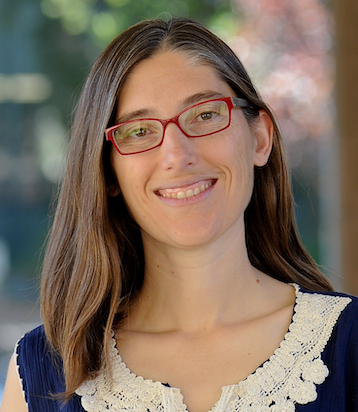Matina Donaldson-Matasci

Associate Professor of Biology
F.W. Olin Science Center, Room 1243
1250 N. Dartmouth Ave.
Claremont, CA 91711
909.607.1572
mdonaldsonmatasci@hmc.edu
Education and Professional Experience
- B.A., Mathematics, Reed College
- PhD, Biology, University of Washington
- Postdoctoral Research Associate, Max Planck Institute for Evolutionary Anthropology (Department of Evolutionary Genetics)
- Postdoctoral Research Associate, University of Arizona (Department of Ecology & Evolutionary Biology)
Teaching
- Bio 46: Introductory Biology (Fall)
- Bio 23: Biology Laboratory (Fall)
- Writ 01: Introduction to Academic Writing (Fall)
- Bio 154: Biostatistics (Spring)
- Math Comp Bio 117: Game Theory and the Evolution of Cooperation (Fall, alternate years)
- Math Comp Bio 118B: Introduction to Computational Biology (Spring, second half)
- Bio 110: Experimental Ecology Laboratory (Spring)
- Bio 186: Topics in Behavioral Ecology (Fall, alternate years)
Research Interests
In the HMC Bee Lab, we study how colonies of social insects, such as bees and ants, coordinate group behaviors. In particular, communication between group members often shapes the activity of the group as a whole. For example, honey bees use a specialized “dance language” to communicate with their nestmates about the location of food sources, which allows the colony to forage efficiently even as resources change. Turtle ant (Cephalotes) colonies coordinate group defense of multiple nests, based on the value and defensibility of each nest. Using a combination of field experiments with honey bees, laboratory experiments with ants, mathematical models and computer simulations, we explore how different types of communication systems are suited to different types of environments and social structures.
See the HMC Bee Lab blog for more information on ongoing research projects, including field experiments on honey bee foraging, mapping the floral landscape using drones and computer vision, and a combination of lab experiments and simulations of the transportation networks of arboreal ants.
Selected Publications
Adams, Benjamin J., Evan M. Gora, Matina C. Donaldson-Matasci, Elva J. H. Robinson, and Scott Powell. 2023. “Competition and Habitat Availability Interact to Structure Arboreal Ant Communities across Scales of Ecological Organization.” Proceedings of the Royal Society B: Biological Sciences 290 (2007): 20231290. Competition and habitat availability interact to structure arboreal ant communities across scales of ecological organization.
Donaldson-Matasci, Matina C., Scott Powell, and Anna Dornhaus. 2022. “Distributing Defenses: How Resource Defendability Shapes the Optimal Response to Risk.” The American Naturalist 199 (5): 636–52. Distributing Defenses: How Resource Defendability Shapes the Optimal Response to Risk.
Chang, Joanna*, Scott Powell, Elva J. H. Robinson, and Matina C. Donaldson-Matasci. 2021. “Nest Choice in Arboreal Ants Is an Emergent Consequence of Network Creation under Spatial Constraints.” Swarm Intelligence 15 (1): 7–30. Nest choice in arboreal ants is an emergent consequence of network creation under spatial constraints.
Lecheval, Valentin, Hannah Larson*, Dominic D. R. Burns, Samuel Ellis, Scott Powell, Matina C. Donaldson-Matasci, and Elva J. H. Robinson. 2021. “From Foraging Trails to Transport Networks: How the Quality-Distance Trade-off Shapes Network Structure.” Proceedings of the Royal Society B: Biological Sciences 288 (1949): 20210430. https://doi.org/10.1098/rspb.2021.0430.
Powell, S, MC Donaldson-Matasci, A Woodrow-Tomizuka** and A Dornhaus. 2017. Context-dependent defenses in turtle ants: resource defensibility and threat level induce dynamic shifts in soldier deployment. Functional Ecology 31 (12): 2287-2298. doi: 10.1111/1365-2435.12926
Rivera, MD*, MC Donaldson-Matasci, and A Dornhaus (2015). Quitting time: When do honey bee foragers decide to stop foraging on natural resources? Frontiers in Ecology and Evolution 3: 1–9. doi:10.3389/fevo.2015.00050
Donaldson-Matasci MC and A Dornhaus (2014). Dance communication affects consistency but not breadth of resource use in pollen-foraging honey bees. PLoS ONE 9 (10): e107527. doi:10.1371/journal.pone.0107527
Donaldson-Matasci MC, CT Bergstrom, and M Lachmann (2013). When unreliable cues are good enough. American Naturalist 182 (3): 313-327. doi:10.1086/671161. [Honorable Mention, ASN Student Paper Award]
Donaldson-Matasci MC, G DeGrandi-Hoffman, and A Dornhaus (2013). Bigger is better: honey bee colonies as distributed information-gathering systems. Animal Behaviour 85 (3): 585-592. doi:10.1016/j.anbehav.2012.12.020 [Nature Research Highlight]
Donaldson-Matasci MC and A Dornhaus. (2012) How habitat affects the benefits of communication in collectively foraging honey bees. Behav Ecol & Sociobiol 66 (4): 583-592. doi:10.1007/s00265-011-1306-z (PDF)
Donaldson-Matasci MC, CT Bergstrom, and M Lachmann. (2010) The fitness value of information. Oikos 119 (2): 219-230. doi:10.1111/j.1600-0706.2009.17781.x (PDF)
Donaldson-Matasci MC, M Lachmann, and CT Bergstrom. (2008) Phenotypic diversity as an adaptation to environmental uncertainty. Evol Ecol Research 10 (4): 493-515. (PDF)
* Undergraduate author ** High school student author